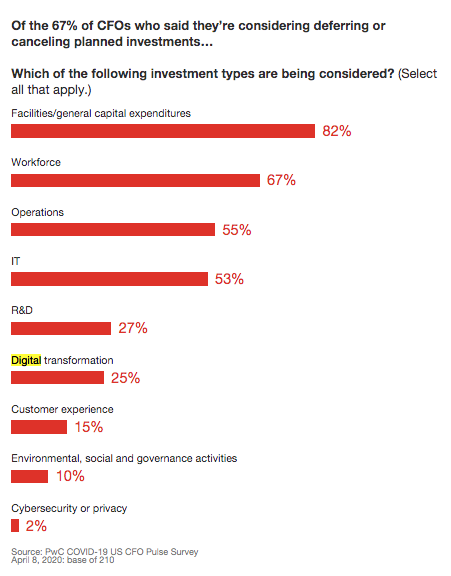
Urgency to switch to digital business is just one way organizations are responding to current disruptions, highlighting the need for dynamic planning. After a virtual meeting with 40 CEOs recently, Fortune CEO Alan Murray wrote: “Companies that previously had been slow to adopt to digital transformation now find themselves on a ‘burning platform.’”
As executives consider changing priorities and reducing or reallocating budgets, enterprise portfolio or program management offices (EPMOs) are in the right position to take center stage. Nearly 70 percent of finance leaders are taking cost containment measures and considering postponing or canceling planned investments, according to PwC’s COVID-19 CFO Pulse Surveys (March 30, 2020 and April 13, 2020). EPMOs and Finance, together, can ensure the leadership team is making the best decisions now and for the future.

Dynamic Planning and Rapid Reprioritization are Key to Moving at Speed
With these capabilities, EPMOs can continuously translate strategy to delivery amid fluctuating priorities, financials, and resources. They can reevaluate current and proposed investments and initiatives, generate what-if scenarios, and compare trade-offs between alternatives. Finance, collaborating with EPMOs, can create more flexible funding models in response to change. Once executives make strategic decisions based on these insights, EPMOs and Finance can work with the organization to shift funding and resources, ensuring a quick response to reprioritization.
Does your EPMO have the capability to:
- Take in new, unplanned strategic initiatives into the portfolio?
- React fast enough to sudden (and unexpected) changes in funding?
- Determine what programs to delay or keep investing in when things get tight?
- Ascertain the impacts of decisions such as, for example, a hold on contractor spend on your portfolio or defunding an investment?
- Work with your PMO leaders to ensure your remote workforce is delivering on strategy?
If not, now is the time to embrace a more adaptable portfolio management approach or at least more fully exploit the existing features in your PPM solution. Your guidance should consider both the short and long term. EPMOs should be exploring how the organization can be more competitive and innovative as we get beyond the current crisis.
In “The CIO’s moment: Leadership through the first wave of the coronavirus crisis,” one of McKinsey & Company’s recommendations is to maintain focus on key priorities:
“In this high-stress situation, the natural instinct is to think about what programs to cut and revert back to old ways of working. It’s important, of course, to reevaluate priorities, shift resources, and track progress closely. But it’s also crucial to see that this current crisis is a major turning point and a competitive situation. We know from past crises, in fact, that companies that take a slash-and-hold approach fare worse than those that both prune and thoughtfully invest.”
The good news is that PwC’s survey found that digital transformation, customer experience, and cybersecurity or privacy are the least likely investments to be cut. EPMOs are in a great position to help fast-track transformation programs and make the organization emerge stronger.
Dynamic Planning and Rapid Reprioritization Capabilities
EPMOs should use the following capabilities to continually iterate based on the evolving needs of the business. Working with Finance and executives, EPMOs can make informed recommendations and operationalize decisions throughout the organization.
Dynamic Planning: In swiftly changing environments, a dynamic planning process enables your organization to pivot and do rapid reprioritization based on the latest data. Your EPMO should be able to make recommendations in the context of the overall portfolio. This includes re-assessing portfolio priorities – both existing and proposed – and aligning them with strategic goals, financial constraints, and resource capacity. EPMO leaders using these capabilities can balance the portfolio across the company’s changing growth, innovation, transformational, and run-the-business activities. They can ensure that people, money, and technologies are realigned to focus on the right programs that will deliver the strategy.
Financial and Capital Planning: In the face of constant change, EPMOs need the ability to continuously analyze current investments versus new demands at the portfolio level. The aim is to determine which investments should be funded, and which should be cancelled, de-scoped, delayed, rejected or postponed based on targets and capacity. A portfolio investment-centric approach creates plans that integrate strategic and organizational financials to promote visibility and drive performance. EPMOs plan and manage capital investment project portfolios from business case to execution, optimizing capital spend over shifts, delays, or new opportunities.
Scenario Planning: The ability to create what-if scenarios quickly is critical to set the right priorities and adjustments. EPMO leaders work with Finance to model the reallocation of funding and resources across the portfolio and compare scenarios. By understanding risks and balancing trade-offs between proposed decisions, EPMOs can help stakeholders make the best decisions and move forward with a reprioritized plan.
Regarding the findings of its COVID-19 CFO Pulse Survey, PwC wrote: “We expect more companies to explore different scenarios regarding the duration of the outbreak and to assess the range of potential impacts on their financial performance.” Companies are also starting to model recovery scenarios, according to the survey.
Program Management: Program management enables EPMOs to define cross-functional plans, track status, and measure progress, from individual initiatives to the overall strategic plan. As executives revise plans, EPMOs must be able to incorporate all the twists and turns of execution and make adjustments as needed. These include real-time developments as well as milestones, resources, releases, schedules, investments, roadmaps, and more. Integrated roadmaps help to implement strategic, operational, and technology changes as well as resolve conflicting priorities and mitigate risk.
Strategic Analytics and Dashboards: Reports, dashboards, and interactive visualizations make it easy for EPMO leaders to support their counsel. Executives and others need access to data to understand the impacts of proposed actions to make decisions. EPMOs should be able to configure role-based screens, reports, dashboard analytics, and workflows based on health data from the projects, programs, and portfolios across the enterprise.
Dynamic Planning and Rapid Reprioritization in Action: Planview Customers
Now is the time for the EPMOs to work with Finance and facilitate the tough decisions to adjust plans and resources. Planview PortfoliosTM and Planview PPM ProTM customers already have dynamic planning capabilities at their fingertips. One customer is reprioritizing its $3 billion capital portfolio by configuring new fields for their COVID-related analysis within a day. They told us: “We don’t know what we would have done without it.”
A major energy customer is analyzing internal projects around the globe and determining which they can terminate or postpone. Another customer, the EPMO of a financial services firm, is working with the CEO to monitor 125 strategic cost-savings initiatives against financial targets.
Planview customers are:
- Translating strategy into delivery on an organization-wide, cross-functional scale.
- Aligning projects, programs, finances, applications, and technology; and building top-down programs that deliver on the organization’s strategy.
- Prioritizing, ranking, and reprioritizing projects based on their alignment with corporate strategies and financials.
- Performing “what-if” analyses and comparing scenarios based on resource utilization, capacity, and funding against benefits, risks, and ROI.
- Easily adapting plans as conditions and priorities change.
The Power of Collaborating More Closely with Finance is Agility
EPMOs have an opportunity to work with Finance to guide the organization beyond the inflexibility of annual plans and funding. They can lead the way to develop new processes and procedures that increase agility. Companies who create the ability to respond faster to change will reap benefits in the short term and beyond.
if you are a Planview customer and not fully using planning capabilities at this time, we’re here to help you now and in the long term. Learn more by watching a short introductory demo, visit Re-Planning and Resilience Amid Disruption. In addition to this blog, read part one in this blog series: Dynamic Planning and Rapid Reprioritization: Resilience Amid Disruption.
Learn more by reading the other blogs in this series:
Part 1: Dynamic Planning and Rapid Reprioritization: Resilience Amid Disruption
Part 3: Rapid Reprioritization: Delivering on Strategy in the Midst of Change
For more information, watch the On-Demand Demo – Portfolios for the Portfolio Manager




![Is It Time to Rethink Traditional Portfolio Management? [Infographic]](https://blog.planview.com/wp-content/uploads/2019/09/Rethink-Traditional-Portfolio-Management.png)

